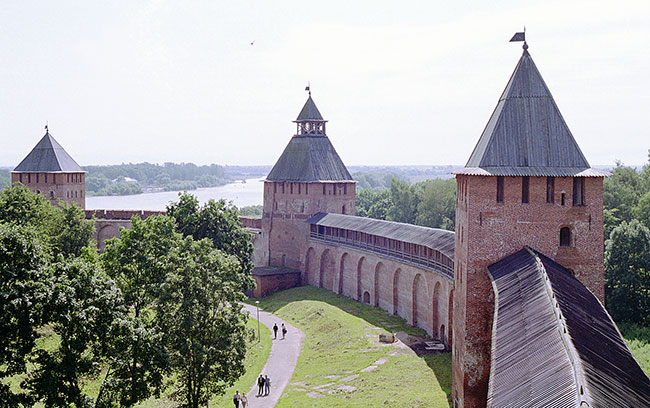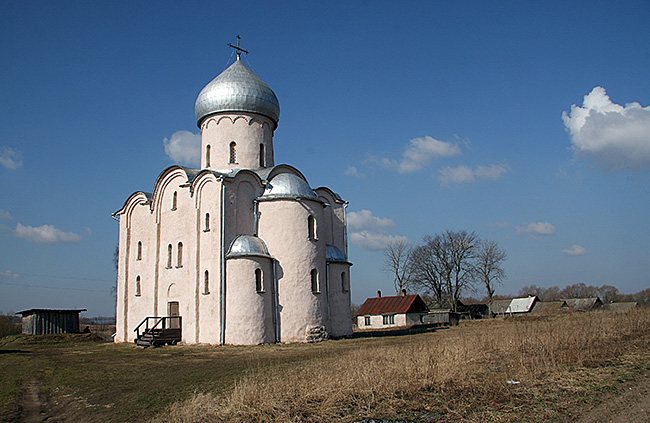Welcome to Velikiy Novgorod
General information
Welcome to Velikiy Novgorod.
Velikiy Novgorod - one of the most ancient cities of Russia located in its North-West, near the site where the Volkhov river takes its waters from Lake Ilmen, emerged as a political center of Slavic and Fino-Ugric tribes in the mid-9th century, while as a town it was formed in the middle of the 10th century.

Alexander Nevsky Embankment
The history of Novgorod is closely linked with all major stages in the life of the Russian state. In those times, when the statehood of Rus was just in the making, the Novgorodians invited Scandinavian prince Rurik to keep law and order, thus giving birth to the prince Rurik dynasty that ruled over all Russian lands throughout more than 750 years.

St. Sophia Cathedral 1045 - 1050
In the early 10th century, war campaigns of the Novgorodians against Constantinople to secure equal trade with Bizantine resulted in the integration of East Slavic tribes into the ancient Kievan Russian state.

Fresco "Apostle Peter"
The adoption of Christianity at the close of the tenth century turned Novgorod into a powerful ecclesiastical center. The efforts of Novgorod Bishops in spreading and promoting the Orthodoxy were given high credit in the mid-12th century when they were elevated to the ranks of Archbishops which made the Bishops Chair of Novgorod the most powerful in the Russian Orthodoxy.

Monument to the Millenium of Russia
The right of Novgorod to select its own princes, that was granted in the middle of the twelfth century, attracted princes to the Novgorod throne. This provided favorable conditions to maintain the unity of Russian lands tending to be feudally divided, while the annexation of the Novgorod republic to the Moscow Principality at the end of the 15th century resulted in the united Russian State with Moscow as the capital.
Throughout many centuries, Novgorod was a political center of vast territories stretching up from the Baltic lands and Finland in the West to the northern Urals in the East. It was also one of the greatest international trade centers on the Baltic-Volga commercial route that tied northern Europe with Asia as early as the mid - 8th century.

Kremlin Intercession Tower. 16th 17th cc.
Novgorod is the cradle of Russian republican and democratic traditions. In the course of over 600 years, up till 1478, all vital decisions on its life and foreign policy were taken by the "veche" - an ancient parliament comprising the representatives of the town aristocracy families. At crucial times of Novgorod's history, every citizen took part in the veche.
The republic's special political structure, spiritual freedom and territorial independence were highly favorable to the evolution of culture and art.
Novgorod was one of Russia's major centers of literacy and book production. As far back as in the 30-s of the 11th century, by the will of the great Prince Yaroslav The Wise, Novgorod saw the first school to train three hundred children at a time.
Medieval Novgorod was one of the greatest art centers of Europe. Its architectural traditions, school of icon-painting, jeweler's and decorative applied art became famous all over the world.

Church of Our Saviour on Nereditsa
The town's military power, its remoteness from dangerous southern borders, successful campaigns against clergical reforms and heresies enabled the city to preserve a unique complex of architectural monuments with frescoes of the 11th - 17th centuries, the oldest Russian manuscripts, chronicles, acts, icons. The only time in its history when Novgorod suffered military damages was in the course of World War II: for over two years the city, being at the front line, was bombed and shelled by both combating armies. Turned into ruins, this city on the Volkhov River was brought to life again by the restorers who managed to revive the old architecture. Welcome to Novgorod! You will be able to visit a unique complex of ancient Russian architectural monuments of the 11th - 17th centuries.

Fresco "St. Ustinia" (church of Our Saviour on Nereditsa)
First of all you will be fascinated by the cathedral of St. Sophia, the Holy Wisdom of God - the oldest surviving Russian stone monument. It was built in 1045. The powerful monolithic massive structure of the monument still dominates not only the Kremlin, but the whole historic downtown of Novgorod. In the interior of this palladion your attention will be drawn by the unique historically formed iconostases, ancient mural paintings, icons - national relics of Russia (including the famous icon of the 12th century - Virgin of the Sign, that was returned back to the cathedral in 1991, when divine services were resumed here), and other relics of Byzantine, Western Europe and Russian art. In the course of hundreds of years the Cathedral of St. Sophia was a center of the clergical, political and cultural life of ancient Novgorod.

You are welcome to admire the monuments of twelfth century Novgorod architecture - the Cathedral of St. Nicholas in Yaroslav's Court and the Church of the Nativity of Our Lady in St. Anthony's Monastery, that have brought to us old fresco painting, carved iconostases, and the necropolis of the 17th - 18th centuries. In the old cloister - the St. George (Yuriev) Monastery, that was founded as early as in the 12th century by Prince Yaroslav the Wise, as a legend reads, one cannot help being amazed by the striking beauty of another masterpiece of ancient Russian architecture - the Cathedral of St. George, built by a certain master mason Peter in 1119.

Archaeological finds from the Museum
Many experts of Russian art justly believe Novgorod to be a Russian Florence; no other old Russian cities have managed to preserve so many ancient architectural monuments adorned with wall murals. You will see that with your own eyes visiting the churches of Our Saviour on Nereditsa Hill and Annunciation of Our Lady on Miachino Lake (12th century): appreciating at its true worth the 14th century frescoes of world-famous Theophanes the Greek in the church of the Transfiguration of Our Saviour on Iliah Street; singularly graceful murals in the churches of the Nativity of Our Lady on Krasnoye Field, St. Theodore Stratilates on the Brook, admiring the beautiful clergical wall calendar of the 15th - 17th centuries in the Church of St. Simeon The Godreceiver: and studying wonderful mural compositions of the late 17th - early 18th centuries in The Virgin of The Sign Cathedral.

Great St. Sophia Zion.
You will, no doubt, be happy with a visit of the Kremlin of Novgorod - the oldest in Russia. This fortress was mentioned in chronicles as early as 1044. The present walls and towers were constructed at the close of the 15th century. The Detinets (that was the original name of the citadel ) was closely related to all the most important events in the life of ancient Novgorod: hosting foreign embassies, seeing-off warriors to fight the enemy, convening veche meetings. In addition to the above-mentioned St. Sophia's Cathedral, the Kremlin also features such other striking monuments as the Faceted (Archbishop's) Palace - a rare specimen of Gothic architecture, built in 1433 jointly with German masters, as well as the impressive and beautiful St. Sophia's Bellfry of 1439 with a set of bells dating back to the 16th - 18th cc.

Icon "St. Nicolas"
In the central square of the Kremlin stands the monument "The Millenium of Russia", designed by Mikhail Mikeshin and erected in 1862. This unique document in bronze immortalizes all those who greatly contributed (in addition to the outstanding Russian politicians) to the development of the country: its culture, science, art, literacy, and literature. Leaving the Kremlin and St. Sophia Quarter of the city, you can get to the opposite bank of the Volkhov by a footbridge. Now we approach the territory of another architectural open-air museum: the Yaroslav's Court and ancient Trade-yard, displaying many still-standing monuments of the 12th - 16th centuries: churches of St. John-The Baptist, Paraskeva-Pyatnitsa, Myrrh-Bearing Women and others - all reminiscent of the busy trade life of Novgorod in days goneby. Yaroslav Court, with its non-suviving wooden palace of Great Prince Yaroslav The Wise, was widely known since the middle of the 8th century as a site of the international Trade-yard, the oldest in northern Europe.

Wrap "Wirgin of the Sign with Selected Saints"

Shroud of Christ "Entombment". 15th c.
A visit to Novgorod usually leaves guests with unforgettable impressions of the inimitable and majestic Novgorod landscape. There are may enchanting sights on the boat tour of Lake Ilmen and the Volkhov river: Peryn - the site of the pre-Christian heathen temple; visiting Lipno island with one of the few preserved architectural specimens of the 13th century - the Church of St. Nicholas, decorated with frescoes of the same period.

Panagirion. 15th c. (Palace of Facets)
You are always welcome at the expositions and exhibitions of one of the most ancient and richest museums of Russia - Novgorod State United Museum, that offers visitors a unique collection of historic, cultural and art relics.

St. George Cathedral. 12th c. Yuriev Monastery
Of a special interest is the Museum's archaeological collection, comprising all relics excavated from the soil of Novgorod in the archaeological research that has been carried out for more than 60 years. The archaeological finds include such world-famous items as a great number of birch-bark scrolls and lead seals dating back to the 12th - 15th centuries. These are indicative of a unique and striking (for medieval times) level of literacy among ancient Russians and also of a highly organized system of state control. The unprecedented rich collection of archaeological relics provides a basis for one of the best Russian historic expositions - the one called "Great Novgorod. Policy. Economy. Culture. 10th - 15th centuries ". It is displayed in the Kremlin's former

Yuriev Monastery
world-famous Novgorod Museum collection of Novgorod school of icon painting covering the 12th - 15th centuries. This can only be thoroughly studied in Novgorod. Not even Moscow or St. Petersburg has this quality of subject matter. A suite of rooms on the second floor of the museum contains the artworks that can be studied.

Virgin of Sign Cathedral. Late 17th c.
It is also only in Novgorod that visitors can admire a unique collection of facial and ornamental embroidery of the 16th - 17th centuries. Exhibited in the Kremlin's St. Ioann building, it features such wonderful works of ancient Russian embroideries as maniples of St. Varlaam of Khutyn (12th c.), shroud, commissioned by Dmitry Shemyaka (15th c.), omophorion of Nicon (17th c.), etc.
Of no less interest is the exhibition of ancient jewelry and decorative-applied art of the 10th to early 20th centuries, which is on display in the main hall of the Faceted (Archbishop's) Palace of the Kremlin. Many of them are indeed unique: Zions from St. Sophia vestry (12th century), Craters of the 12th century, cloisonne enamels (10th - 12th centuries), panagiarion from the vestry of St. Sophia Cathedral (15th century), panagia of Archbishop Pimen (16th century).

Yaroslav's Court and Ancient Torg
The open-air architectural-ethnographic museum "Vitoslavlitsy" provides a whole complex of genuine folk wooden architecture, including ancient churches of the 16th - 18th centuries and peasant houses of the 19th - early 20th centuries, exhibitions of folk art and everyday life items of Novgorod peasants of the same period.